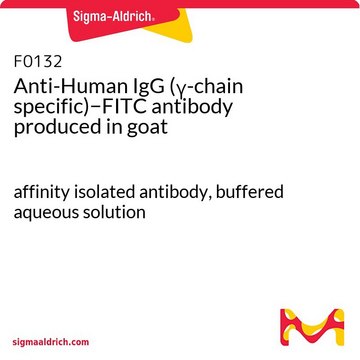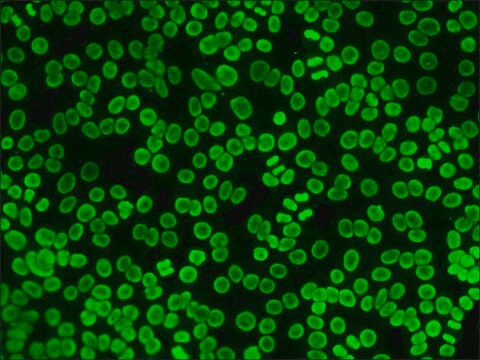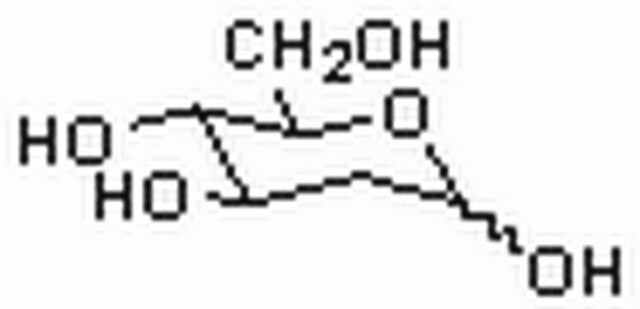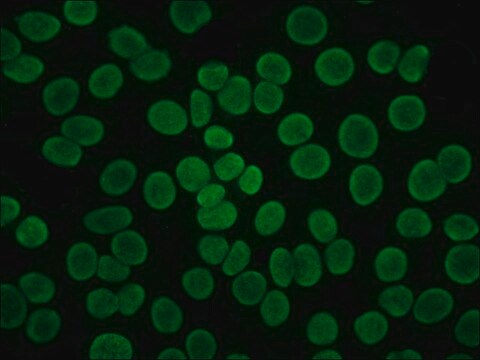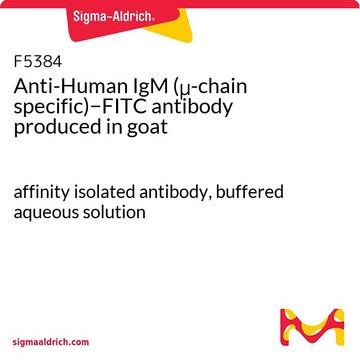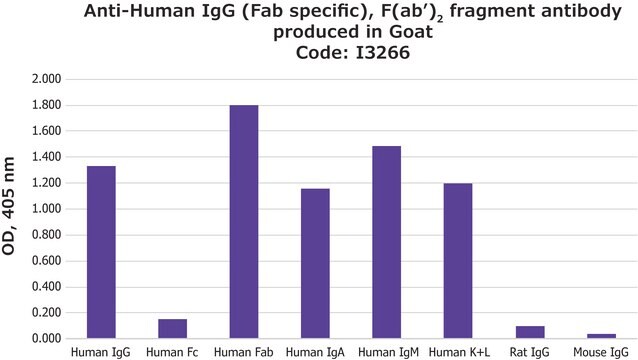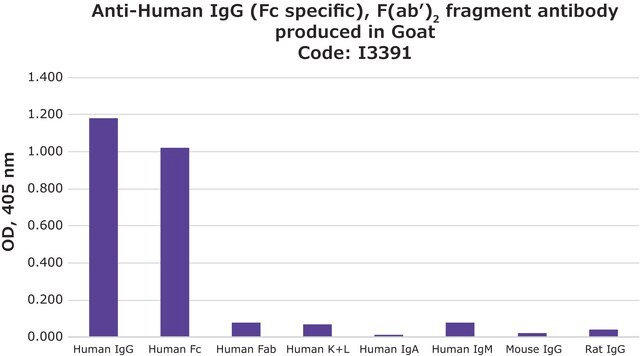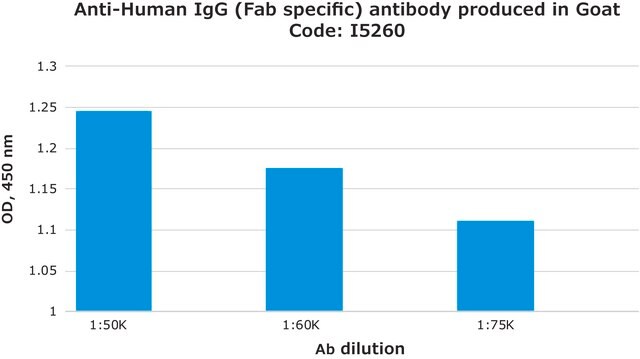F1641
Anti-Human IgG (γ-chain specific), F(ab′)2 fragment–FITC antibody produced in goat
affinity isolated antibody, buffered aqueous solution
Synonyme(s) :
Anti-Human IgG FITC
Se connecterpour consulter vos tarifs contractuels et ceux de votre entreprise/organisme
About This Item
Produits recommandés
Source biologique
goat
Conjugué
FITC conjugate
Forme d'anticorps
affinity isolated antibody
Type de produit anticorps
secondary antibodies
Clone
polyclonal
Forme
buffered aqueous solution
Technique(s)
direct immunofluorescence: 1:32
Température de stockage
2-8°C
Modification post-traductionnelle de la cible
unmodified
Description générale
Human IgGs are glycoprotein antibodies that contain two equivalent light chains and a pair of identical heavy chains. IgGs have four distinct isoforms, ranging from IgG1 to IgG4. These antibodies regulate immunological responses to allergy and pathogenic infections. IgGs have also been implicated in complement fixation and autoimmune disorders
Anti-Human IgG (γ-chain specific), (F(ab′)2) fragment-FITC antibody is specific for human IgG when tested against purified human IgA, IgG, IgM, Bence Jones κ and λ myeloma proteins. The use of this product prevents background staining due to the presence of Fc receptors.
Anti-Human IgG (γ-chain specific), (F(ab′)2) fragment-FITC antibody is specific for human IgG when tested against purified human IgA, IgG, IgM, Bence Jones κ and λ myeloma proteins. The use of this product prevents background staining due to the presence of Fc receptors.
Immunoglobulin G (IgG) belongs to the immunoglobulin family and is a widely expressed serum antibody. The two heavy chains and two light chains of IgG are connected by a disulfide bond. It is a glycoprotein and mainly helps in immune defense. IgG is usually found as a monomer. IgG antibody subtype is the most abundant of serum immunoglobulins of the immune system. It is secreted by B cells and is found in blood and extracellular fluids. About 70 percent of the total immunoglobulin consists of IgG. Immunoglobulin G (IgG) participates in hypersensitivity type II and type III.
Immunogène
Purified human IgG
Application
Anti-Human IgG (γ-chain specific), (F(ab′)2) fragment-FITC antibody is suitable for use in direct immunofluorescence (1:32).
Anti-Human IgG (γ-chain specific), F(ab′)2 fragment−FITC antibody has been used in immunofluorescence studies and flow cytometric crossmatch (FCXM).
Forme physique
Solution in 0.01 M phosphate buffered saline pH 7.4, containing 1% bovine serum albumin and 15 mM sodium azide
Clause de non-responsabilité
Unless otherwise stated in our catalog or other company documentation accompanying the product(s), our products are intended for research use only and are not to be used for any other purpose, which includes but is not limited to, unauthorized commercial uses, in vitro diagnostic uses, ex vivo or in vivo therapeutic uses or any type of consumption or application to humans or animals.
Vous ne trouvez pas le bon produit ?
Essayez notre Outil de sélection de produits.
Code de la classe de stockage
12 - Non Combustible Liquids
Classe de danger pour l'eau (WGK)
nwg
Point d'éclair (°F)
Not applicable
Point d'éclair (°C)
Not applicable
Faites votre choix parmi les versions les plus récentes :
Déjà en possession de ce produit ?
Retrouvez la documentation relative aux produits que vous avez récemment achetés dans la Bibliothèque de documents.
Les clients ont également consulté
M A Ilham et al.
Transplantation proceedings, 40(6), 1839-1843 (2008-08-05)
Pretransplantation crossmatching is an integral part of kidney transplantation. Flow cytometric crossmatch (FCXM) is more sensitive than complement-dependent cytotoxic crossmatch (CDC-XM). However, the clinical significance of positive FCXM with negative CDC-XM is controversial. We evaluated FCXM in 455 consecutive deceased
Işın Sinem Bağcı et al.
Experimental dermatology, 30(5), 684-690 (2020-12-22)
Ex vivo confocal laser scanning microscopy (CLSM) offers real-time examination of excised tissue in reflectance, fluorescence and digital haematoxylin-eosin (H&E)-like staining modes enabling application of fluorescent-labelled antibodies. We aimed to assess the diagnostic performance of ex vivo CLSM in identifying
Işın S Bağcı et al.
Journal of biophotonics, 12(9), e201800425-e201800425 (2019-04-26)
Ex vivo confocal laser scanning microscopy (ex vivo CLSM) offers an innovative diagnostic approach through vertical scanning of skin samples with a resolution close to conventional histology. In addition, it enables fluorescence detection in tissues. We aimed to assess the
I S Bağcı et al.
Journal of the European Academy of Dermatology and Venereology : JEADV, 33(11), 2123-2130 (2019-07-03)
Ex vivo confocal laser scanning microscopy (ex vivo CLSM) is a novel diagnostic method allowing rapid, high-resolution imaging of excised skin samples. Furthermore, fluorescent detection is possible using fluorescent-labelled antibodies. To assess the applicability of ex vivo CLSM in the
Işın Sinem Bağcı et al.
Acta dermato-venereologica, 97(5), 622-626 (2017-01-18)
Linear IgG deposits along the basement membrane of adnexa has been proposed to be useful in the diagnosis of bullous pemphigoid (BP), but no controlled studies have been performed. This study evaluated linear IgG fluorescence of the basement membrane of
Notre équipe de scientifiques dispose d'une expérience dans tous les secteurs de la recherche, notamment en sciences de la vie, science des matériaux, synthèse chimique, chromatographie, analyse et dans de nombreux autres domaines..
Contacter notre Service technique
